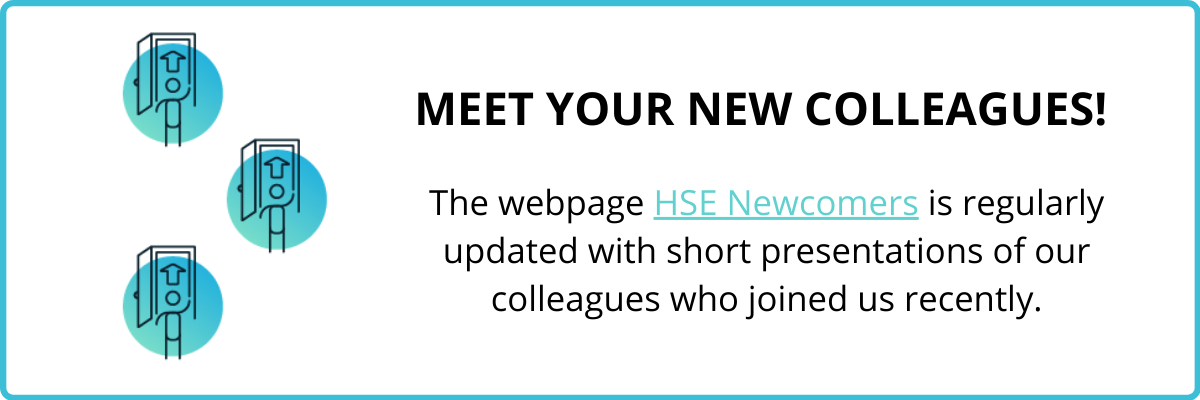
June 2022
Welcome to the HSE Newsletter, the first in a series to be published at least twice a year and featuring some selected highlights for the HSE Unit.
We thank the contributors to this first edition and encourage anyone who has a newsworthy story to share it with us at hse-comms@cern.ch. We will then publish it on the most appropriate channel, including the CERN Bulletin or the HSE website.
Keep up to date at any time with all latest updates by navigating to the “HSE latest News” section of the Unit’s webpages.
A PDF-version of this newsletter is available on EDMS.
Happy reading!
Contents
 |
|
|
Renovation of HSE buildings and facilities (Bldg. 24 and 57). |
A face lift for HSE offices and facilities
This spring, several HSE offices and facilities got a facelift. Renovation works were carried out in building 57, where a part of the OHS Group has their offices and in building 24, which is shared between the HSE Head Office, TS, ENV and part of the RP Group. The newly painted walls, now cream- or café latte and new flooring have given a fresh look and feel to these old buildings, much to the delight of their occupants. A first big step has thus been made, with finishing touches still being applied in building 24 and further floor renovation to be carried out in the near future.
Click here to read more
Another long-standing space management project is the extension of the environmental laboratory located in Building 167 on the Meyrin site, which is nearing completion. This laboratory is dedicated to analyses of water samples from the main discharges from CERN, comprising both the preparation and analysis of radiological and physicochemical samples. The results are needed to monitor and quantify the impact of CERN's activities on the public and the environment, to demonstrate compliance with applicable regulations and to anticipate any major environmental concerns. These major works that began in June 2021 have seen the surface area of the environmental analysis laboratory double to reach 180 m2. The new extended space allows an optimised distribution between the radiological and physicochemical analysis devices.
The different renovation works have required careful planning and stakeholder discussions, led by the HSE Space Manager, Audrey Deidda, a sizeable budget, provided both by HSE and SCE, and a careful follow-up by the respective TSOs, Valérie Tromel and Céline Ecarnot and André Dziewa.
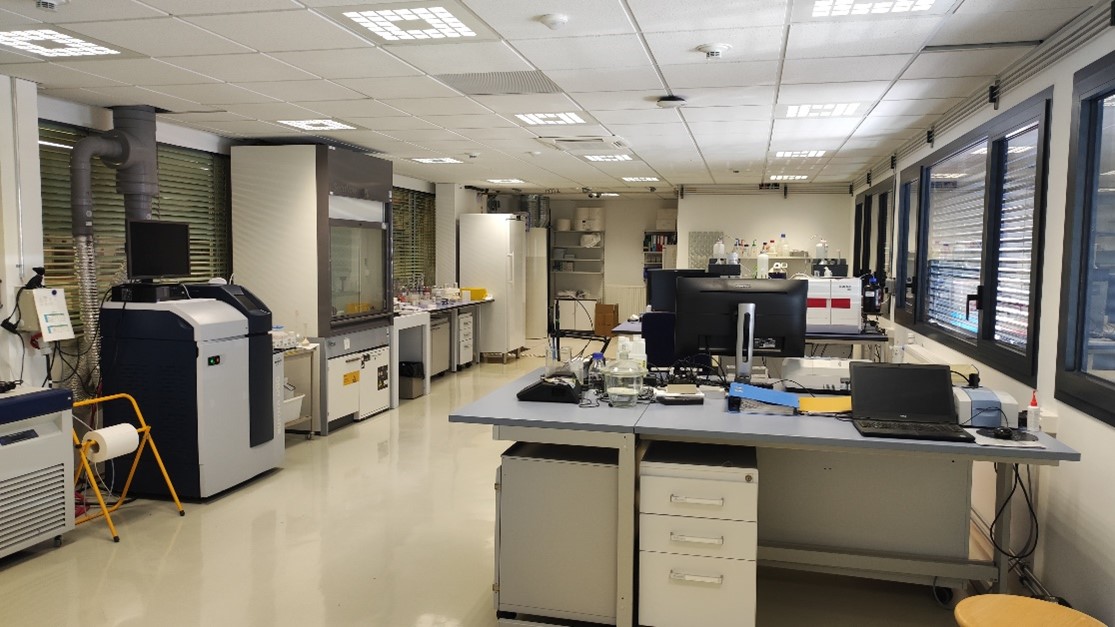 |
|
| The renovated environmental laboratory in Bldg. 167. |
The launch of the HOR project
11 May saw the official launch of the HSE Operational Response (HOR) project by the Unit Head, Benoît Delille and the Project Leader, Pierre Bonnal. It featured presentations of the project’s work packages by their leaders Christoph Schaeffer, Sabrina Schadegg, Yves Loertscher and Raphael Otzenberger.
Click here to read more
The project’s objective is to design a clear and effective framework for HSE operational response. This includes comprehensive means to communicate to internal and external stakeholders regarding the services provided by HSE, and to allow HSE Unit members to access the appropriate and consistent information when needed. This will be achieved through comprehensive mapping of the HSE operational response, enhanced definitions of the roles of HSE members, adapted and widely communicated operational processes and better integrated deliverables (document types, information system). The project comprises five main work packages:
- WP1 — Stakeholders Cartography;
- WP2 — Safety Risks and Emergency Identification;
- WP3 — Medical and Personal Assistance Response;
- WP4 — Environment and Asset Emergency Response;
- WP5 — Safety Inspections and Safety Reviews Response.
A sixth work package, WP6 — Framework Design and Implementation, serves as overarching coordination and oversight for the project.
The HOR project will mobilise all groups in HSE. For example, the OHS group leads two specific work packages in this project, WP3 and WP5. WP3 is dedicated to the different tasks of the Medical Service, i.e. occupational health, insurance medicine and first-line health support for everyone on the CERN site. One of the challenges for this work package will be to make the medical follow-up of members of the personnel more risk based and to re-enforce prevention. Together with the HR department, there will also be some reflection as to how to improve the follow-up of long-term illness. Finally, ensuring that the CERN community has access to appropriate medical support in case of emergency at a reasonable cost remains a concern. Communicating the changes resulting from this work package in a timely and appropriate manner will be key. The HSE communications team will work in close collaboration with the different stakeholders, such as HR services, the CERN Health Insurance Scheme (CHIS) and the Users’ Office to meet this particular challenge.
WP5 will focus on developing a review procedure for equipment but also for activities. The main goal will be to consider the protection of people not only through technical solutions but also through the ways in which workers interact with hazards. Knowing one’s work environment is safe leads to greater wellbeing and productivity, and therefore this will have direct and tangible benefits for both the members of the personnel and the Organization.
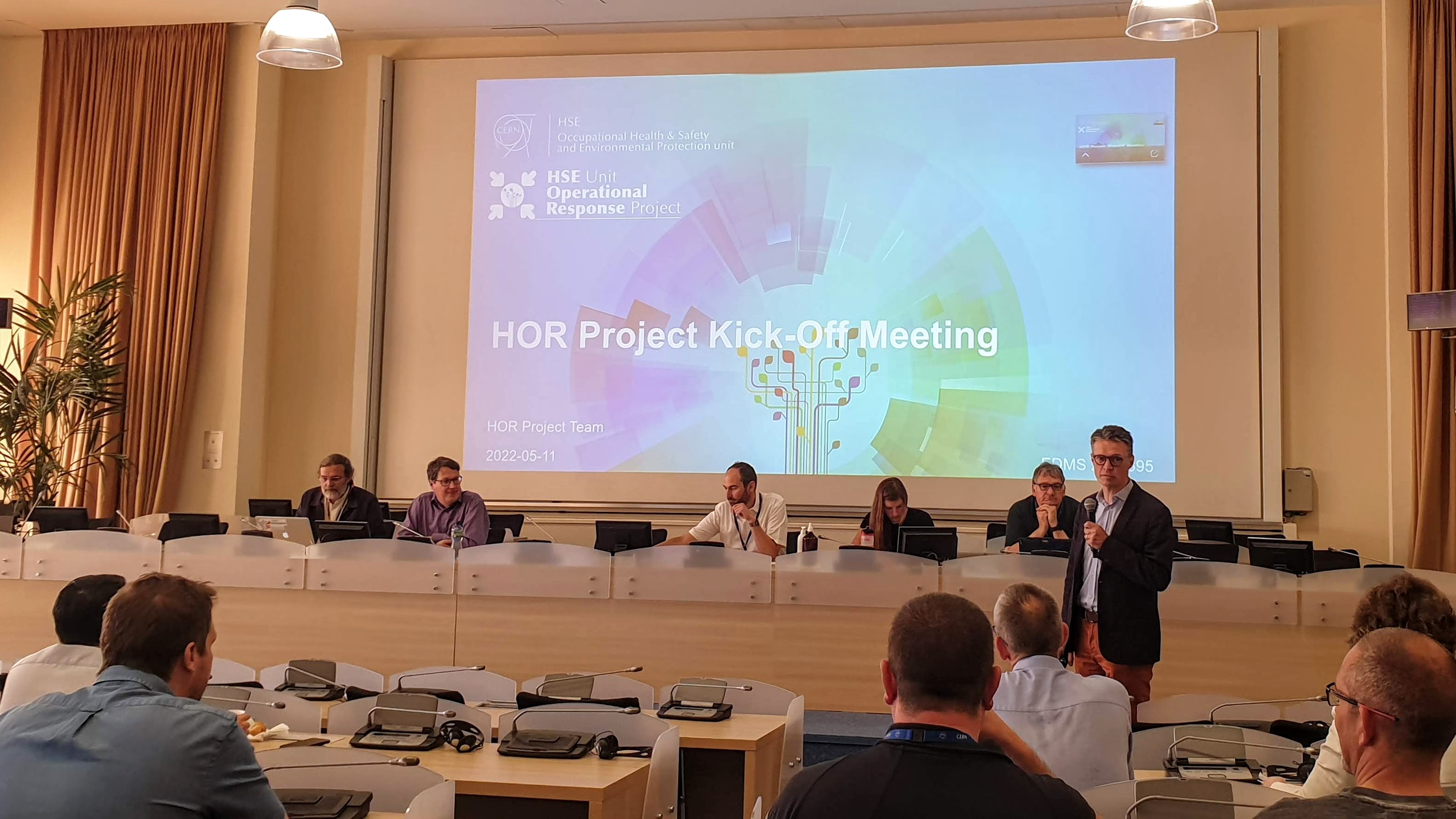 |
|
| HOR project launch event — 11 May 2022 in the Council Chamber. |
Environmental and radiation monitoring: progress on many fronts
Monitoring ionising radiation and other emissions generated by CERN’s activities is a regulatory requirement for CERN. The HSE unit operates an impressive monitoring system aimed at ensuring that radiation levels and various emissions remain well within legal limits. The operation, maintenance and upgrade of the system are a continuous challenge.
The ARCON to CROME project
Ionising radiation monitoring is one of the key roles of the RP Group. When radiation exceeds predefined levels or suitable protection cannot be ensured, the operation of the accelerators has to be stopped. 2021 saw the completion of the project started in 2014 to replace the legacy monitoring solution, the ARea CONtroller (ARCON) system used since the 1980’s, with the new CERN RadiatiOn Monitoring Electronics (CROME). CROME will, in time, cover all CERN sites and experiments. This brand-new generation of radiation monitoring systems was developed fully in-house by a small team in HSE-RP and its mass production has been almost entirely carried out at CERN, thanks to intra-departmental collaboration with TE, BE, EN and EP supported by industrial partners from ten countries.
Click here to read more
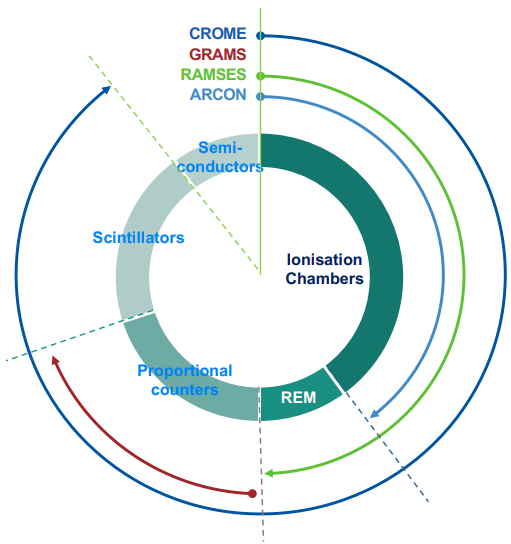 |
|
| The various generations of radiation monitoring at CERN. |
It features a decentralised, modular architecture comprising a versatile interface, ensuring continuous real-time monitoring of ambient dose equivalent rates, an alarm and interlock functionality, long-term permanent and reliable data logging and powerful processing capabilities for embedded calculation. The key points that make the CROME system unique are broad measurement capability and operational reliability. CROME has a nine-decade current measurement capability ranging from a few femto-amperes, allowing measurements from ambient background in the environment, to pulsed radiation in the vicinity of accelerators and experiments. Its operational reliability is ensured by three pillars: the development process to reduce systematic failures, a thorough dependability study according to the IEC 61508 standard including functional verification to reduce random failures, and a continuous monitoring of the correct behaviour of the system during its operation.
CROME is already deployed in the PS Booster, PS, n-TOF, SPS, SM18, HL-LHC UPRs and the North Area, integrating more than 500 RP monitoring devices. Its full completion, with a further 1500 devices integrated, is expected by 2028 in time for the HL-LHC.
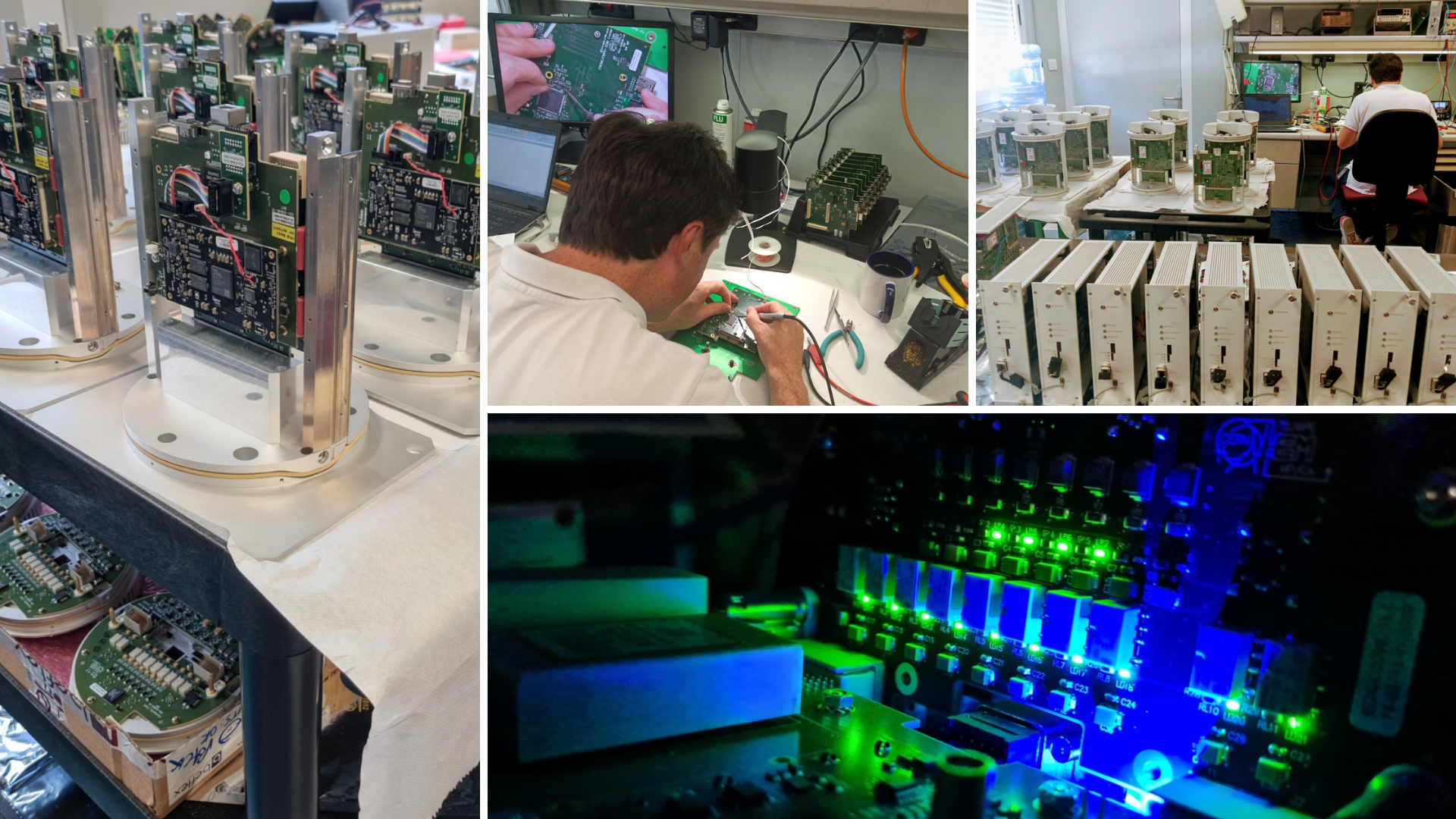 |
|
| Illustrations of the CROME components. |
Radiological & Environmental Monitoring System (REMS): New Data Analytics capabilities
HSE’s radiation monitoring system requires smart solutions in terms of supervision and analysis of the data collected. As monitors evolve, so does the corresponding SCADA (Supervisory Control and Data Acquisition) system, that is developed and maintained by the HSE-TS-CS Section in close collaboration with the RP and the ENV Groups. 90 billion measurement data points are being acquired and archived every year by the HSE Radiation and Environment Monitoring Unified Supervision system, REMUS.
Click here to read more
In the past three years, innovative solutions using data streaming, big data and web technologies have been implemented in order to streamline the data analysis of radiological and environmental data.
The REMADS (REMUS Analytics and Data Services) project, completed in December 2021, allowed HSE to make an important step towards the rationalisation of data analysis. Among other features, the REMUS Web platform now centralises data analytics tools for REMUS users.
The REMAC (REMUS Advanced Capabilities) project, which kicked-off in 2022, will take this further, inter-connecting with additional CERN systems, and automating generation of reports.
A seminar on 21 June 2022 will be dedicated to the exploitation of data of the Radiological and Environmental Monitoring System, REMS. It provides an overview of the new possibilities offered, and the benefits it could bring to HSE teams, with information on how to extract the data, generate and share statistics and reports, and links it to other CERN systems such as the Enterprise Asset Management tool InforEAM or HelpAlarm (link only accessible from within the CERN site).
Migration of monitoring stations to InforEAM
Since 2021 HSE has undertaken to move the maintenance and operation of its environmental monitoring stations from Sharepoint to InforEAM, a system used CERN-wide for diverse asset management tasks. The migration is well underway with 2200 recordings already logged to enable systematic and automated follow-up. All water stations are already registered in the system and the process is expected to be completed by September. The work spans 650 measurement channels and implies the centralisation of all fact-findings, procedures, station details and of the collected data. It will ensure autonomy of those intervening on the stations, who will be able to operate them themselves using a simple mechanism.
The RP/RS tripartite agreement and CERN's disposal of radioactive waste
In 2010, the bilateral agreements on radiation protection and radiation safety between CERN and its Host States were replaced by a tripartite agreement that celebrated its ten years of entry into force last autumn.
Click here to read more
This treaty creates a legal framework to discuss how the common objective of protecting people working on site and the public against ionising radiation can best be achieved in the context of CERN. The Host States are represented by the Swiss Federal Office of Public Health (FOPH) and the French Nuclear Safety Authority, the Autorité de Sûreté Nucléaire (ASN).
The subjects discussed within the framework of the tripartite agreement concern the inter-site transport of radioactive materials, the declaration of incidents with radiological implications, the export and import and handling of radioactive materials, dosimetry, environmental monitoring and, last but not least, the management and disposal of radioactive waste.
The disposal of its radioactive waste remains a critical subject for the Organization that produces up to 641 tonnes of radioactive waste per year. The agreement allows CERN to eliminate radioactive waste in the two Host States by using the most technically and economically advantageous pathways in both countries. As France and Switzerland have different approaches and pathways, this principle allows CERN to optimise its radioactive waste elimination by choosing the most appropriate solution for each category of waste. The agreement requires however that these solutions ensure an equitable distribution of CERN radioactive waste between the two countries (the “fair share” principle).
The implementation of the fair share principle was defined in a decision of 2012 that reflected the very limited experience of radioactive waste elimination by CERN at that time. On 14 March 2022, the 2012 decision was replaced by a new one reflecting the experience gained and lessons learnt in the past ten years.
The new decision will allow CERN to eliminate the Laboratory’s most radioactive waste towards the future deep geological repository in Switzerland while exploiting the full capacity of the French pathways for low- and medium level radioactive waste.
This revised decision also improves the monitoring of the fair share with three indicators: the volume eliminated, radiotoxicity and elimination costs. With these indicators, it will now be possible to better compare and measure the share between the two Host States, with a follow-up at the annual tripartite plenary meetings.
The new fair share decision has demonstrated that the RP/RS tripartite agreement and process are robust and allow to adapt to regulatory and technical evolutions. It also is a very strong demonstration of an excellent collaboration between CERN and its Host States.
The LHC beam dump core autopsy
From 30 May to 3 June, the European conference of the International Radiation Protection Association (IRPA2022) will take place in Budapest. This is one of the most important conferences in the field which takes place every four years. On this occasion, HSE-RP is presenting two papers: one on general studies for the upgrade of the LHC to HL-LHC in preparation for LS3, and another on the LHC beam bump core autopsy.
Click here to read more
 |
|
| The LHC beam dump core autopsy |
The LHC beam dump core autopsy, a multidisciplinary project undertaken during LS2, revolved around the unprecedented action of dismantling the two LHC beam dumps at Point 6 in view of an upgrade for Run 3. This long and complex intervention allowed teams to gather crucial information for designing future generations of beam dumps for the HL-LHC era.
Two key challenges of the project were the dumps’ removal from the accelerator and preparing these highly activated objects for its elimination as radioactive waste. Prior to its removal, the dump selected for autopsy was cut into pieces, which later permitted to inspect the state of the inner graphite. The dumps are also among the first objects in the “intermediate and low-level radioactive waste” (FMA waste) category that will be subjected to new, dedicated disposal pathways, that CERN is currently discussing with the French authorities. ANDRA, the operator of the French radioactive waste repositories, visited the worksite to gather knowledge and understanding on properties and treatment of such type of waste.
The dump autopsy at CERN was a first and the specific RP challenges were considerable, owing to high residual doses, possible contamination, and general uncertainties. The corresponding infrastructure had to be designed and developed with in-house expertise and implicated several sections from the RP group. They contributed to the planning of all stages of the operation, from conducting state-of-art simulations to predict the dose rate and activation levels, to defining a dedicated worksite and the necessary protection measures for the people working there. Further, a review of the step-by-step intervention sequence was performed, to respect the ALARA principle and globally minimise personnel exposure.
The project has been highly successful, demonstrating the capability and know-how of the teams at CERN, allowing considerable cost savings for the Organization and providing key information for the future generation of beam dumps and for optimised dismantling procedures for LS3 and beyond.
New Safety trainings
With CERN in COVID risk level “Green”, the HSE Safety Training Section can now again offer Safety Training sessions, using the LHC tunnel. This is much appreciated by both trainers and participants.
Click here to read more
 |
|
|
The first edition of the SST course in March 2022 |
The relaxation of COVID-19 related measures has also allowed to schedule the first course of the Workplace First Aider (SST) programme that is part of in a new first aid training scheme, launched in September 2021. It comprises two complementary programmes: The first programme, First Aid – Life-Saving Actions is open to everyone working at CERN and covers basic first-aid techniques in just three hours. The Safety Training Section hopes to train several hundred persons each year with the aim to maximise the number of emergency first responders on site.
The second part of the scheme, the First Aid – Workplace First-aider (SST1) programme spans two days, and its completion leads to the award of a certificate. This particular programme is reserved for members of the personnel put forward by the departments and experiments according to their strategic emergency response requirements and the specific risks at play. In addition to training people to perform first aid in the event of workplace accidents, this programme also focuses on prevention, i.e. reducing occupational risks.
As all fire trucks are now equipped with foam to tackle specific hazards in CERN installations in case of a fire, the Fire and Rescue Service has completed a brand-new foam training zone. The zone has been designed in a way to minimise the impact of the training on the environment with a dedicated 10m3 sewage tank for the foam recuperation.
1. SST : Sauveteur secouriste du travail / workplace first-aider.
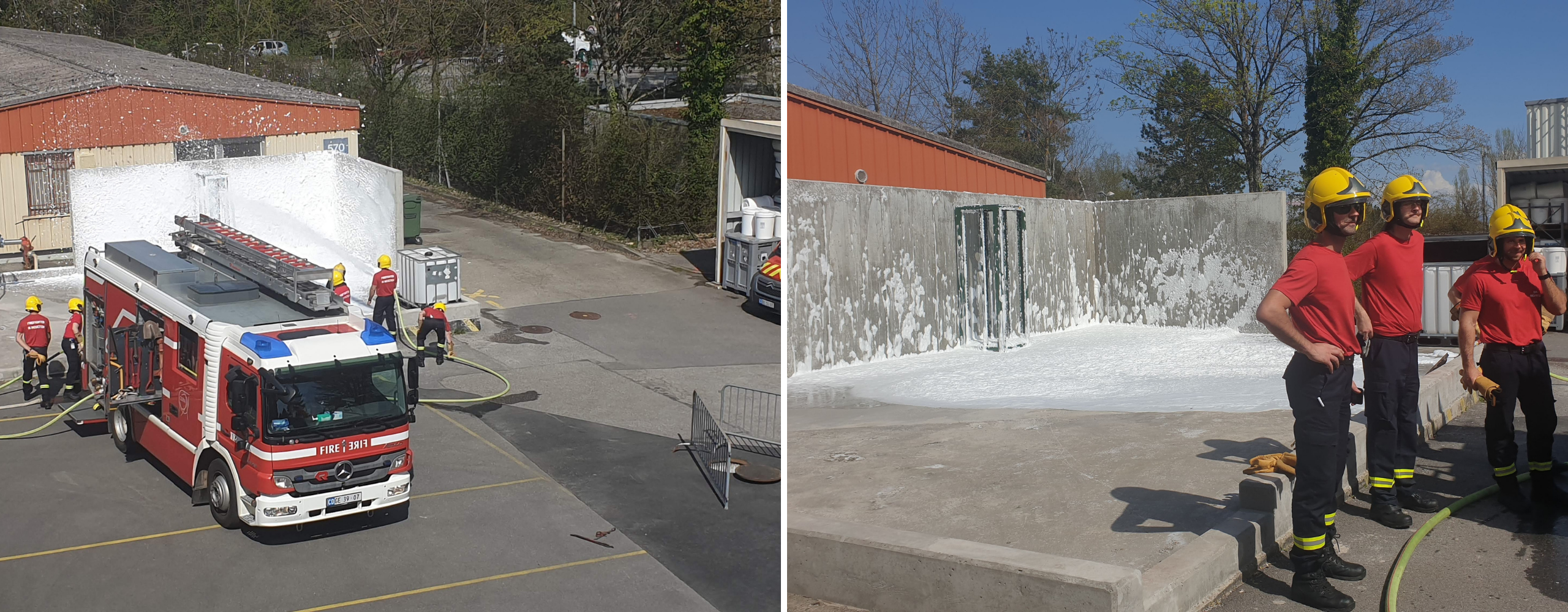 |
|
| The new foam training zone at the CERN FRS. |
HSE Newcomers
